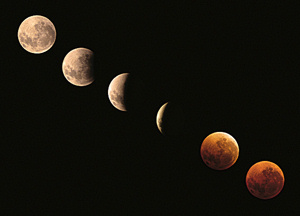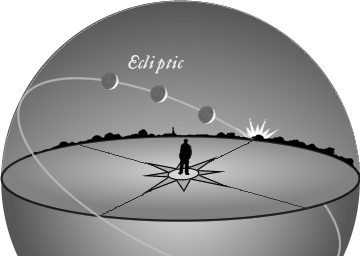We have been receiving a number of inquiries about some upcoming Blood Moons in the years 2014 and 2015. And we want to say, first of all, that the Blood Moons most people are asking about are not part of astronomy. Instead, their origin is religious, at least according to Christian pastor John Hagee, who wrote a 2013 book about Blood Moons. More about that below. Still, since they’re moons, and since people are asking us, we wanted to reply.
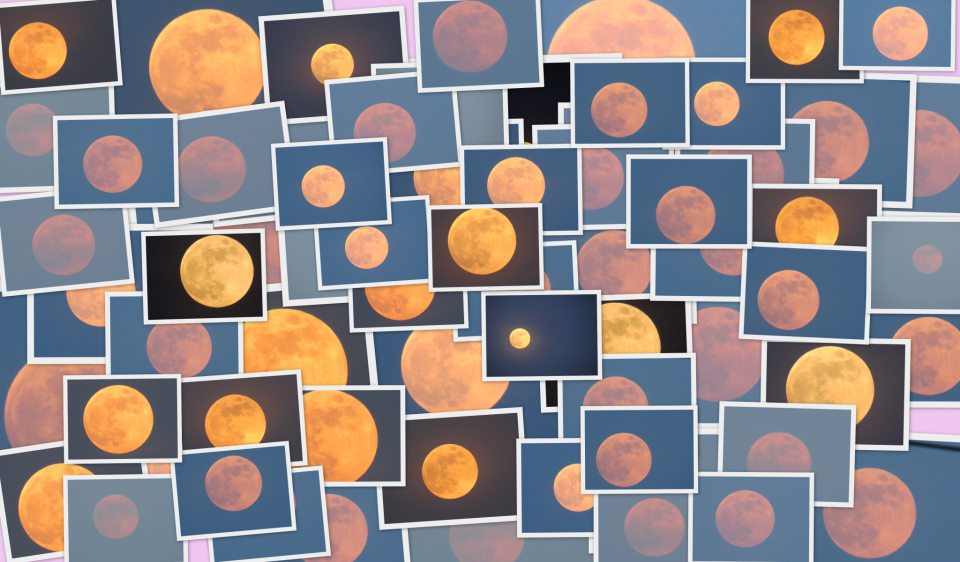
Hunter’s Moon collage from EarthSky Facebook friend Kausor Khan in Hyberabad, India. Notice that she choose reddish moons to depict the Hunter’s Moon. That’s because many people see the Hunter’s Moon low in the sky, and moons seen low in the sky appear reddish. In 2013, the Hunter’s Moon – sometimes called the Blood Moon – came in mid-October.
Blood Moons in astronomy. In astronomical lore, all the full moons have names. The names typically coincide with months of the year, or seasons.
One of the most famous moon names isthe Hunter’s Moon. It is the the full moon immediately following the Harvest Moon, which is the full moon occurring most closely to the autumnal equinox.
The Hunter’s Moon, in skylore, is also sometimes called the Blood Moon. Why? Probably because it’s a characteristic of these autumn full moons that they appear nearly full – and rise soon after sunset – for several evenings in a row. Many people see them when they are low in the sky, shortly after they’ve risen, at which time there’s more atmosphere between you and the moon than when the moon is overhead. When you see the moon low in the sky, the extra air between you and the moon makes the moon look reddish. Voila. Blood moon.
Why is a Hunter’s Moon linked in people’s minds with a red moon? First of all, in autumn, the angle of the ecliptic – or sun and moon’s path – makes a narrow angle with the horizon. Image via classicalastronomy.com.

Secondly, the narrow angle of the ecliptic means the moon rises noticeably farther north on the horizon, from one night to the next. So, every autumn, there is no long period of darkness between sunset and moonrise. Around the time of full moon, many people see the moon low in the sky, around the time of twilight. At that time, the moon often looks reddish. Image via classicalastronomy.com.
Dates for the Northern Hemisphere’s Harvest and Hunter’s Moons in 2014 and 2015:
2014:
Harvest Moon: September 9
Autumn Equinox: September 23
Hunter’s (Blood) Moon: October 82015:
Autumn Equinox: September 23
Harvest Moon: September 28
Hunter’s (Blood) Moon: October 27
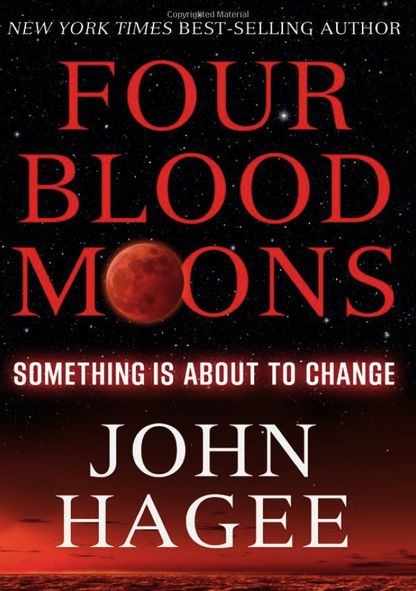
This book, published in 2013, is apparently what launched all the questions to our astronomy website about Blood Moons. We confess. We haven’t read it.
Blood Moons in Biblical prophecy. We’re not experts on prophecy of any kind. But we’ll tell you what we know about the new definition for Blood Moon that has caused so many questions recently.
From what we’ve been able to gather, two Christian pastors, Mark Blitz and John Hagee, use the term Blood Moon to apply to the full moons of the upcoming tetrad – four successive total lunar eclipses, with no partial lunar eclipses in between, each of which is separated from the other by six lunar months (six full moons) – in 2014 and 2015. John Hagee appears to have popularized the term in his 2013 book Four Blood Moons: Something is About to Change.
Mark Blitz and John Hagee speak of a lunar tetrad as representing a fulfillment of Biblical prophecy. After all, the moon is supposed to turn blood red before the end times, isn’t it? As described in Joel 2:31 (Common English Bible):
The sun will be turned to darkness, and the moon to blood before the great and dreadful day of the LORD comes.
That description, by the way, describes both a total solar eclipse and total lunar eclipse. Sun turned to darkness = moon directly between the Earth and sun in a total solar eclipse. Moon turned to blood = Earth directly between the sun and moon, Earth’s shadow falling on the moon in a total lunar eclipse.
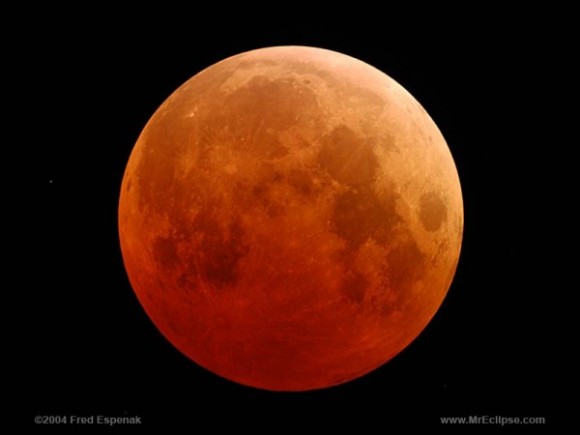
This is what a total eclipse looks like. This is the total eclipse of October 27, 2004 via Fred Espenak of NASA.Visit Fred’s page here. We astronomy writers often describe a totally eclipsed moon as appearing ‘blood red.’
We astronomy writers often describe total lunar eclipses as appearing blood red. Why red? They appear reddish because sunlight from all of Earth’s sunrises and sunsets is scattered by the Earth’s atmosphere and falls on the surface of the eclipsed moon. In years where volcanic activity is pronounced, however, a total lunar eclipse may appear more brownish or gray in color.Read more here: Why does the moon look red during a total lunar ecl...
Dates of Biblical prophecy Blood Moons in 2014 and 2015. These are the dates for the upcoming tetrad – four successive total lunar eclipses – in these years.
2014:
Total lunar eclipse: April 15
Total lunar eclipse: October 82015:
Total lunar eclipse: April 4
Total lunar eclipse: September 28
There are a total of 8 tetrads in the 21st century (2001 to 2100). But proponents of this Biblical prophecy regard the upcoming tetrad as especially significant because it coincides with two important Jewish holidays: Passover and Tabernacles.
The April 2014 and April 2015 total lunar eclipses align with the feast of Passover. The October 2014 and September 2015 total lunar eclipses align with the feast of Tabernacles.
The Jewish calendar is a lunar calendar. In any year, it’s inevitable that a full moon should fall on or near the feasts of Passover (15 Nissan) and Tabernacles (15 Tishri). Nissan and Tishri are the first and seventh months of the Jewish calendar, respectively.
It is somewhat ironic that three of these four lunar eclipses are not visible – even in part – from Israel. The only eclipse that can be seen at all from Israel is the tail end of the September 28, 2015 eclipse, which may be observable for a short while before sunrise.
How common is a tetrad of total lunar eclipses? Depending upon the century in which you live, a lunar tetrad (four consecutive total lunar eclipses, spaced at six lunar months apart from one another) may happen fairly frequently – or not at all.
For instance, in our 21st century (2001-2100), there are a total 8 tetrads, but in the 17th, 18th and 19th centuries, there were none at all. If we include all the centuries from the 1st century (AD 1-100) through the 21st century (2001-2100), inclusive, there are a total of 62 tetrads. The last one occurred in 2003-2004, and the next one after the 2014-2015 tetrad will happen in 2032-2033.
However, if we want to know which tetrads specifically fell on the Jewish feasts of Passover and Tabernacles, there appear to be a total of 8 in these 21 centuries:
1. 162-163 C.E. (Common Era)
2. 795-796 C.E.
3. 842-843 C.E.
4. 860-861 C.E.
5. 1493-1494 C.E.
6. 1949-1950 C.E.
7. 1967-1968 C.E.
8. 2014-2015 C.E.
Why is the term Blood Moon being used to mean a full moon of a lunar tetrad? We can’t really tell you why more and more people are using the term Blood Moon to describe the four full moons of a lunar tetrad. We don’t know why, exactly.
Here’s the definition of a lunar tetrad, again: four successive total lunar eclipses, with no partial eclipses in between, each of which is separated from the other by six lunar months (six full moons). There’s no obvious reason why Blood Moon should be associated with this term.
To the best of our knowledge, however, the use of the term Blood Moon to describe a lunar tetrad is of recent origin. It might have originated with John Hagee’s 2013 book.
We’re still not sure whether Blood Moon pertains to the full moon of any tetrad, or specifically to a tetrad that coincides with the feasts of Passover and Tabernacles.
Either way, I suspect the nouveau definition of Blood Moon will gain traction as we approach the tetrad, the four total lunar eclipses of 2014 and 2015.
Bottom line: The term Blood Moon in astronomy in sometimes used as another name for the Hunter’s Moon. The term Blood Moon in Biblical prophecy appears to have been popularized by two Christian pastors, Mark Blitz and John Hagee. They use the term Blood Moon to apply to the full moons of the upcoming tetrad – four successive total lunar eclipses, with no partial lunar eclipses in between, each of which is separated from the other by six lunar months (six full moons) – in 2014 and 2015. Astronomers will not be using the term Blood Moon to describe these four upcoming lunar eclipses.
Why does the moon look red during a total lunar eclipse?
|
During a lunar eclipse, you’ll see the Earth’s shadow creeping across the moon’s face. The shadow will appear dark, like a bite taken out of a cookie, until the shadow completely covers the moon. Then, during the breathtaking time of totality, the shadow on the moon’s face often suddenly changes. Instead of dark, it appears red. Why?
The reason stems from the air we breathe. During a total lunar eclipse, the Earth lies directly between the sun and the moon, causing the Earth to cast its shadow on the moon. If Earth didn’t have an atmosphere, then, when the moon was entirely within Earth’s shadow, the moon would would appear black and invisible.
Thanks to Earth’s atmosphere, what actually happens is much more subtle and beautiful.
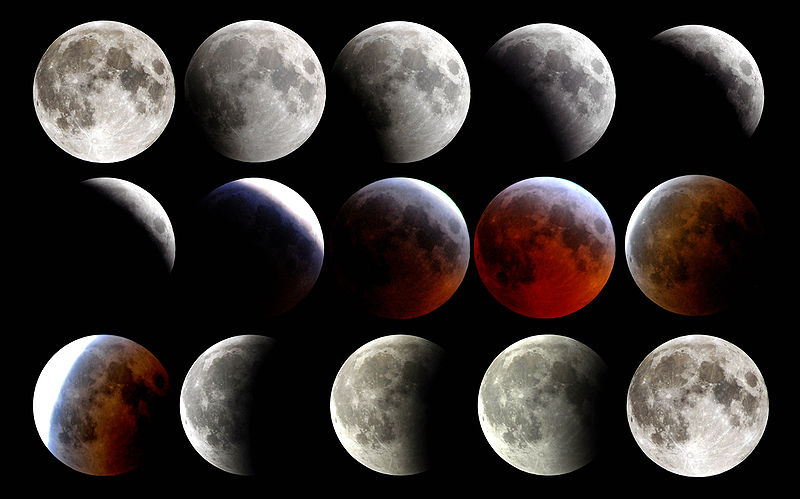
Lunar eclipse of March 3, 2007. Image by Joshua Valcarcel via Wikimedia Commons.
Earth’s atmosphere extends about 50 miles (80 kilometers) above Earth’s surface. During a total lunar eclipse, when the moon is submerged in Earth’s shadow, there is circular ring around Earth – the ring of our atmosphere – through which the sun’s rays pass.
Sunlight is composed of a range of frequencies. As sunlight passes through our atmosphere, the green to violet portion of the light spectrum is, essentially, filtered out. This same effect, by the way, is what makes our sky blue during the day. Meanwhile, the reddish portion of the spectrum is least affected.
What’s more, when this reddish light first entered the atmosphere, it was bent (refracted) toward the Earth’s surface. It’s bent again when it exits on the other side of Earth. This double bending sends the reddish light onto the moon during a total lunar eclipse.
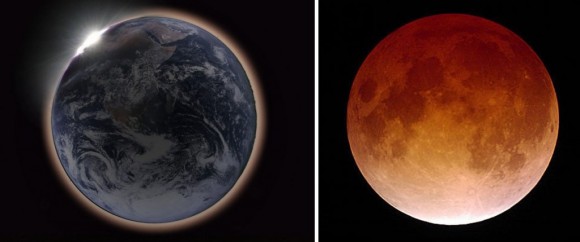
Apollo astronauts acquired the photo at left, and the Japanese lunar probe Kaguya acquired the one at right, during a 2009 total lunar eclipse. At left, you see the view of a person standing on the moon during a total lunar eclipse. Sunlight is shining through Earth’s atmosphere. At right, the fully eclipsed moon takes on the reddish color of sunlight filtered and refracted through Earth’s atmosphere. Photo Credits: JAXA (left), Jim Fakatselis (right). Images via AstroBob
Depending on the conditions of our atmosphere at the time of the eclipse (dust, humidity, temperature and so on can all make a difference), the surviving light will illuminate the moon with a color that ranges from copper-colored to deep red.
In December 1992, not long after the eruption of Mount Pinatubo in the Philippines, there was so much dust in Earth’s atmosphere that the totally eclipsed moon could barely be seen.
Can anyone know in advance how red the moon will appear during a total lunar eclipse? Not precisely. Before an eclipse takes place, you’ll often hear people speculating about it. That uncertainty is part of the fun of eclipses, so enjoy! And watch for the red moon during a lunar eclipse.

A lunar eclipse takes place when the sun, Earth and moon line up in space. The moon passes through Earth’s shadow. (Wikimedia Commons)
Bottom line: A moon may look red during a total lunar eclipse because of sunlight that is filtered and refracted by Earth’s atmosphere.
